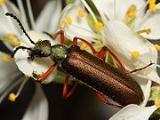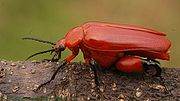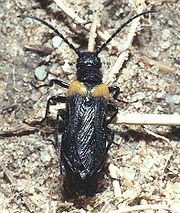
Blister beetle
Encyclopedia
Blister beetles are beetle
s (Coleoptera) of the family
Meloidae, so called for their defensive secretion of a blistering agent, cantharidin
. There are approximately 7,500 known species
worldwide. Many are conspicuous and some aposematically colored, announcing their toxicity to would-be predators.
is a poisonous chemical that causes blistering of the skin. Cantharidin is used medically to remove warts and is collected for this purpose from species of the genera Mylabris and Lytta, especially Lytta vesicatoria, better known as "Spanish fly".
Blister beetles are hypermetamorphic, going through several larval stages, the first of which is typically a mobile triungulin. The larva
e are insectivorous, mainly attacking bee
s, though a few feed on grasshopper
eggs; while sometimes considered parasitoid
s, it appears that in general, the meloid larva consumes the immature host along with its provisions, and can often survive on the provisions alone, thus they are not obligatory parasitoids but rather food parasites that are facultatively parasitoid, or simply predatory. The adults sometimes feed on flowers and leaves of plants of such diverse families like Amaranthaceae
, Asteraceae
, Fabaceae
, and Solanaceae
.
s. A few beetles consumed in a single feeding of alfalfa
hay may be lethal. Poisonings have also been reported after use of "Spanish fly
"-type folk medicine
s, and after handling blister beetle individuals. The toxic chemical is cantharidin
.
Tribe Morphozonitini
Tribe Eleticini
Tribe Spasticini
Beetle
Coleoptera is an order of insects commonly called beetles. The word "coleoptera" is from the Greek , koleos, "sheath"; and , pteron, "wing", thus "sheathed wing". Coleoptera contains more species than any other order, constituting almost 25% of all known life-forms...
s (Coleoptera) of the family
Family (biology)
In biological classification, family is* a taxonomic rank. Other well-known ranks are life, domain, kingdom, phylum, class, order, genus, and species, with family fitting between order and genus. As for the other well-known ranks, there is the option of an immediately lower rank, indicated by the...
Meloidae, so called for their defensive secretion of a blistering agent, cantharidin
Cantharidin
Cantharidin, a type of terpenoid, is a poisonous chemical compound secreted by many species of blister beetle, and most notably by the Spanish fly, Lytta vesicatoria. The false blister beetles and cardinal beetles also have cantharidin.-History:...
. There are approximately 7,500 known species
Species
In biology, a species is one of the basic units of biological classification and a taxonomic rank. A species is often defined as a group of organisms capable of interbreeding and producing fertile offspring. While in many cases this definition is adequate, more precise or differing measures are...
worldwide. Many are conspicuous and some aposematically colored, announcing their toxicity to would-be predators.
Description
CantharidinCantharidin
Cantharidin, a type of terpenoid, is a poisonous chemical compound secreted by many species of blister beetle, and most notably by the Spanish fly, Lytta vesicatoria. The false blister beetles and cardinal beetles also have cantharidin.-History:...
is a poisonous chemical that causes blistering of the skin. Cantharidin is used medically to remove warts and is collected for this purpose from species of the genera Mylabris and Lytta, especially Lytta vesicatoria, better known as "Spanish fly".
Blister beetles are hypermetamorphic, going through several larval stages, the first of which is typically a mobile triungulin. The larva
Larva
A larva is a distinct juvenile form many animals undergo before metamorphosis into adults. Animals with indirect development such as insects, amphibians, or cnidarians typically have a larval phase of their life cycle...
e are insectivorous, mainly attacking bee
Bee
Bees are flying insects closely related to wasps and ants, and are known for their role in pollination and for producing honey and beeswax. Bees are a monophyletic lineage within the superfamily Apoidea, presently classified by the unranked taxon name Anthophila...
s, though a few feed on grasshopper
Grasshopper
The grasshopper is an insect of the suborder Caelifera in the order Orthoptera. To distinguish it from bush crickets or katydids, it is sometimes referred to as the short-horned grasshopper...
eggs; while sometimes considered parasitoid
Parasitoid
A parasitoid is an organism that spends a significant portion of its life history attached to or within a single host organism in a relationship that is in essence parasitic; unlike a true parasite, however, it ultimately sterilises or kills, and sometimes consumes, the host...
s, it appears that in general, the meloid larva consumes the immature host along with its provisions, and can often survive on the provisions alone, thus they are not obligatory parasitoids but rather food parasites that are facultatively parasitoid, or simply predatory. The adults sometimes feed on flowers and leaves of plants of such diverse families like Amaranthaceae
Amaranthaceae
The flowering plant family Amaranthaceae, the Amaranth family, contains about 176 genera and 2,400 species.- Description :Most of these species are herbs or subshrubs; very few are trees or climbers. Some species are succulent....
, Asteraceae
Asteraceae
The Asteraceae or Compositae , is an exceedingly large and widespread family of vascular plants. The group has more than 22,750 currently accepted species, spread across 1620 genera and 12 subfamilies...
, Fabaceae
Fabaceae
The Fabaceae or Leguminosae, commonly known as the legume, pea, or bean family, is a large and economically important family of flowering plants. The group is the third largest land plant family, behind only the Orchidaceae and Asteraceae, with 730 genera and over 19,400 species...
, and Solanaceae
Solanaceae
Solanaceae are a family of flowering plants that include a number of important agricultural crops as well as many toxic plants. The name of the family comes from the Latin Solanum "the nightshade plant", but the further etymology of that word is unclear...
.
Toxicity
The blister beetle genus Epicauta is highly toxic to horseHorse
The horse is one of two extant subspecies of Equus ferus, or the wild horse. It is a single-hooved mammal belonging to the taxonomic family Equidae. The horse has evolved over the past 45 to 55 million years from a small multi-toed creature into the large, single-toed animal of today...
s. A few beetles consumed in a single feeding of alfalfa
Alfalfa
Alfalfa is a flowering plant in the pea family Fabaceae cultivated as an important forage crop in the US, Canada, Argentina, France, Australia, the Middle East, South Africa, and many other countries. It is known as lucerne in the UK, France, Australia, South Africa and New Zealand, and known as...
hay may be lethal. Poisonings have also been reported after use of "Spanish fly
Spanish fly
The Spanish fly is an emerald-green beetle in the family Meloidae, Lytta vesicatoria. Other species of blister beetle used by apothecaries are often called by the same name...
"-type folk medicine
Folk medicine
-Description:Refers to healing practices and ideas of body physiology and health preservation known to a limited segment of the population in a culture, transmitted informally as general knowledge, and practiced or applied by anyone in the culture having prior experience.All cultures and societies...
s, and after handling blister beetle individuals. The toxic chemical is cantharidin
Cantharidin
Cantharidin, a type of terpenoid, is a poisonous chemical compound secreted by many species of blister beetle, and most notably by the Spanish fly, Lytta vesicatoria. The false blister beetles and cardinal beetles also have cantharidin.-History:...
.
Subfamily Eleticinae
Tribe Derideini- Anthicoxenus
- Deridea
- Iselma
- Iselmeletica
Tribe Morphozonitini
- Ceriselma
- Morphozonitis
- Steniselma
Tribe Eleticini
- Eletica
Tribe Spasticini
- Eospasta
- Protomeloe
- Spastica
- Xenospasta
Subfamily Meloinae

- Anisarthrocera
- CerocomaCerocomaCerocoma is a genus of blister beetle, whose biology is poorly known. As in other members of the family, these insects are hypermetamorphic. Larval hosts of few species were described. Imagines show distinct sexual dimorphism in the feeding apparatus and the antennae...
- Diaphorocera
- Rhampholyssa
- Rhampholyssodes
Tribe Epicautini
- Denierella
- Epicauta
- Linsleya
- Psalydolytta
Tribe Eupomphini
- Cordylospasta
- Cysteodemus
- Eupompha
- Megetra
- Phodaga
- Pleropasta
- Tegrodera


- Acrolytta
- Afrolytta
- Alosimus
- Berberomeloe
- Cabalia
- Dictyolytta
- Eolydus
- Epispasta
- Lagorina
- Lydomorphus
- Lydulus
- Lydus
- Lytta
- Lyttolydulus
- Lyttonyx
- Megalytta
- Muzimes
- OenasOenasOenas is a genus of blister beetle related to the well-known Lytta vesicatoria . The genus is Mediterranean in its distribution ....
- Parameloe
- Paroenas
- Physomeloe
- Prionotolytta
- Prolytta
- Pseudosybaris
- Sybaris
- Teratolytta
- Tetraolytta
- Trichomeloe
Tribe Meloini
- Cyaneolytta
- Lyttomeloe
- MeloeMeloeThe blister beetle genus Meloe is a large, widespread group commonly referred to as oil beetles. They are known as "oil beetles" because they release oily droplets of hemolymph from their joints when disturbed; this contains cantharidin, a poisonous chemical causing blistering of the skin and...
- Spastomeloe
- Spastonyx
Tribe Mylabrini
- Actenodia
- Ceroctis
- Croscherichia
- Hycleus
- Lydoceras
- Mimesthes
- Mylabris
- Paractenodia
- Pseudabris
- Semenovilia
- Xanthabris
Tribe Pyrotini
- Bokermannia
- Brasiliota
- Denierota
- Glaphyrolytta
- Lyttamorpha
- Picnoseus
- Pseudopyrota
- Pyrota
- Wagneronota
Genera incertae sedis
Incertae sedis
, is a term used to define a taxonomic group where its broader relationships are unknown or undefined. Uncertainty at specific taxonomic levels is attributed by , , and similar terms.-Examples:*The fossil plant Paradinandra suecica could not be assigned to any...
Subfamily Nemognathinae


- Cissites
- HoriaHoria (beetle)Horia is a genus of beetles in the family Meloidae. They are placed in a tribe Horiini which includes two other genera Synhoria and Cissites....
- Synhoria
Tribe Nemognathini
- Cochliophorus
- Euzonitis
- Gnathium
- Gnathonemula
- Leptopalpus
- Megatrachelus
- Nemognatha
- Palaestra
- Palaestrida
- Pseudozonitis
- Rhyphonemognatha
- Stenodera
- Zonitis
- Zonitodema
- Zonitolytta
- Zonitomorpha
- Zonitoschema
Tribe Sitarini
- Allendeselazaria
- Apalus
- Ctenopus
- Glasunovia
- Nyadatus
- Sitaris
- Sitarobrachys
- Stenoria
Genera incertae sedis
Incertae sedis
, is a term used to define a taxonomic group where its broader relationships are unknown or undefined. Uncertainty at specific taxonomic levels is attributed by , , and similar terms.-Examples:*The fossil plant Paradinandra suecica could not be assigned to any...
- Hornia
- Onyctenus
- Sitaromorpha
- Tricrania
Subfamily Tetraonycinae
Tribe Tetraonycini- Meloetyphlus
- Opiomeloe
- Tetraonyx
External links
- Blister Beetle Intoxication: Cantharidin Poisoning
- meloidae.com
- blister beetles UFUniversity of FloridaThe University of Florida is an American public land-grant, sea-grant, and space-grant research university located on a campus in Gainesville, Florida. The university traces its historical origins to 1853, and has operated continuously on its present Gainesville campus since September 1906...
/ IFASInstitute of Food and Agricultural SciencesThe University of Florida’s Institute of Food and Agricultural Sciences is a federal-state-county partnership dedicated to developing knowledge in agriculture, human and natural resources, and the life sciences, and enhancing and sustaining the quality of human life by making that information...
Featured Creatures - striped blister beetle, Epicauta vittata UFUniversity of FloridaThe University of Florida is an American public land-grant, sea-grant, and space-grant research university located on a campus in Gainesville, Florida. The university traces its historical origins to 1853, and has operated continuously on its present Gainesville campus since September 1906...
/ IFASInstitute of Food and Agricultural SciencesThe University of Florida’s Institute of Food and Agricultural Sciences is a federal-state-county partnership dedicated to developing knowledge in agriculture, human and natural resources, and the life sciences, and enhancing and sustaining the quality of human life by making that information...
Featured Creatures
* Beetle mania as 'extinct' insect found on Scots isle
* Ever so Strange: Blister Beetles

